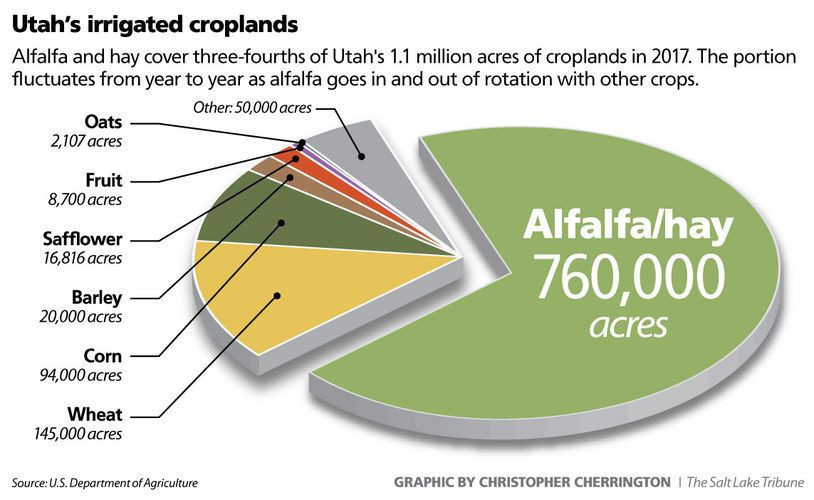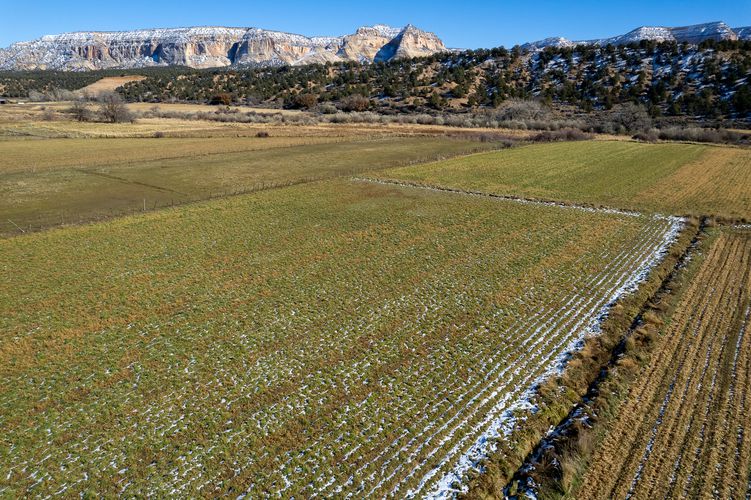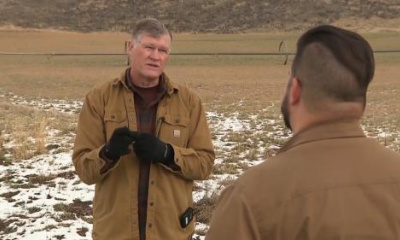Hay and alfalfa feed beef and dairy production and support rural life, but together, they soak up two-thirds of Utah’s water.
Mount Carmel — When the water is running through the ditches connecting her fields to Virgin River tributaries, Dusty Reese and her family don’t get a lot of sleep.
Lacking a pressurized irrigation system, the Kane County ranchers roam the alfalfa fields guiding where the water goes to ensure the fields are flood irrigated as efficiently as possible. The process can go well into the night.
“It’s really hard to control your water,” says Reese during a recent tour of one of her stubbled plots in Utah’s Long Valley, not long after bringing in the last harvest of the season. “It is not something you can just turn on and leave like a wheel line or a pivot. You actually have to walk up and down your field to check and make sure that the water is getting where it needs to go and [dig] with a shovel.”
The Utah Farm Bureau’s Kane County president, Reese, and her husband John farm and run cattle in this 13-mile-long valley framing the Virgin River’s east fork as it flows between the Markagunt and Paunsaugunt plateaus, the top two steps of the Grand Staircase.
It’s a place of bucolic beauty where artist Maynard Dixon lived in the 1940s creating his famous landscape paintings at a rustic retreat he built not far from where the Reeses now work the soil. Small farms line the valley bottom, looking much the way it looked during Dixon’s time.
But these days, growers have an increasingly complicated relationship with the liquid asset so vital to their survival. As Utah’s climate changes, less water is available, while municipal and industrial demands keep growing and lakes shrivel into puddles.
“The key question is how do we save the Great Salt Lake and all the darts and arrows point back to agriculture,” one Farm Bureau official said at a recent public meeting.
450,000 gallons to produce a ton
The Reeses are among the state’s 9,300 family hay-growing operations, which consume most of Utah’s water resources. Alfalfa and other types of hay are by far Utah’s most valuable agricultural crop, worth nearly half a billion dollars last year. But that represents just 0.2% of the state’s gross domestic product — on par with revenue generated by amusement parks.
The 2.4 million tons of annual hay the state produces plays a vital role supporting Utah’s agricultural economy, especially ranchers and dairies, but it comes at a price, experts say.
While Utah’s urban dwellers must rein in their notoriously high use of water, the state won’t solve its water woes without serious concessions from the agricultural sector, according to University of Utah economics professor Gabriel Lozada.
Alfalfa and hay account for 68% of the 5.1 million acre-feet of water diverted every year in Utah, Lozada’s research has found. That means it takes 1.38 acre-feet, or about 450,000 gallons, to produce a ton of alfalfa — about as much water as two Utah homes typically use in a year. (An acre-foot is the amount of water it takes to cover one acre of land with one foot of water.)
According to federal data, 29% of Utah’s hay harvest, by value, is exported overseas, with about two-thirds going to China. Up to 1 million acre-feet were used to produce this hay, depending on how many tons this share of the harvest’s value represents, according to Lozada’s calculations.
Could Utah put that water to better use elsewhere without leaving agriculture producers high and dry?
Lozada and others think so, but it would require overhauling Utah’s 19th-century water law so that farmers are rewarded for using less water, and reducing subsidies on the water they are entitled to use.
“Lots of people have warm and generous feelings towards farmers and rural life, but the vast majority of Utahns live in cities and suburbs,” Lozada said. “If you look at what generates the economic vitality of the state, it’s not our farming sector. It’s services, tech, health care, education, retail and transportation."
That’s not to say that agriculture does not make critical and irreplaceable contributions to Utah’s overall quality of life. Irrigated alfalfa provides numerous environmental and social benefits that are tricky to quantify, but the cost of devoting so much water to a single crop is becoming increasingly and painfully clear as Utah’s water supplies get depleted.
Hidden costs
Scientific studies link Great Salt Lake’s record low water levels to upstream diversions, most of which are feeding agriculture in the Weber, Bear and Provo basins. Saving the lake, which supports $1.3 billion in economic output and internationally significant migratory bird habitat, has become a top priority among state leaders.
Driven also by unrelenting drought, dropping lake levels are not only disrupting robust brine shrimp and mineral industries, but they could also tee up an air quality nightmare for Utah’s urban corridor should exposed lakebed sediments become airborne.
“In economics, by definition, you’re trading off one good thing against another good thing. There are lots of good things about large, prosperous agricultural sectors and stable rural communities,” Lozada says. “But the cost of that, frankly, given the aridification of our climate, is probably horrendous degradation of the quality of life on the Wasatch Front.”
Lozada’s point isn’t to pit urban against rural communities, but rather to encourage reforms so that rural prosperity doesn’t come at the expense of the downstream environment and Utah cities, or vice versa.
Good for the soil
Hay grows on nearly three-fourths of Utah’s 1.1 million acres of irrigated croplands, although that share fluctuates year to year as alfalfa goes in and out of rotation with other crops, like triticale, a wheat hybrid, or corn.

Before laying blame for Utah’s water woes on alfalfa, agronomists say, it’s important to note the pivotal role this high-protein plant plays in rural communities, not to mention its broad environmental benefits.
“It’s a universal feed for cows, horses, goats, anything, and it has the protein that a lot of animals can accept and do really well on,” says fourth-generation Sanpete County rancher Stan Jensen. " I don’t know of another crop around here that would bring in the yield and the income and serve as many purposes as alfalfa.”
He devotes 100 of his farm’s 500 acres to alfalfa. He estimates 5 feet of water are applied to every inch of land that grows the crop, an amount equal to 160 million gallons.
When managed properly, alfalfa cultivation improves soil and reduces carbon emissions, according to Tony Richards, who heads the Utah Department of Agriculture and Food’s (UDAF) soil health program.
As a perennial legume, alfalfa plants fix nitrogen into the soil and they need to be replanted just once every 5 to 10 years. Accordingly, alfalfa requires far less fertilizer and tilling than most other crops, which lessens its environmental footprint and keeps more carbon and nutrients in the ground.
After five or more years of harvesting from the same alfalfa plants over and over, farmers usually switch to corn or some other crop that draws from the nitrogen from the soil for a few years before replanting the alfalfa. And some farmers grow hay grasses and alfalfa together in ways that maximize yields.
“You can run an alfalfa stand for its whole life and never put any nitrogen [fertilizer] on it,” Richards says. “In a soil health context, alfalfa is a great crop.”
And the plants’ taproots extend up to 15 feet into the ground, which benefits the soil in other ways.
“You have this big root line going all the way down. It’s seeking deeper water so it can go through resiliency with drought,” Larsen says, “but at the same time it is creating a channel that water can infiltrate down through the soil better.”
These deep roots, in other words, enable the ground to absorb water more quickly, which also reduces erosion.
“If we do have a 1-inch rainstorm, are you able to infiltrate all of that inch or is it leaving your field, going somewhere else and taking soil with it as usually is the case?” Richards says. “That infiltration is critical because that water that goes down deep, it also recharges the aquifer. It’s what creates our springs.”
Why alfalfa works for Utah growers
Though it requires lots of water, alfalfa is a good fit with the West’s high-elevation landscapes, according to Ryan Larsen, a Utah State University economics professor.
On Utah’s high-elevation arid steppe, alfalfa is often grown where the land can’t support other crops profitably, particularly in Millard and Iron counties.
“There’s not really much else you could do on that land,” Larsen says. “Alfalfa really is our way of extracting the most value from this land.”
This crop is typically harvested two to four times a year, yielding on average around 3.8 tons per acre. How much depends on availability of water, timing of the harvests and the farmers’ goals, according to rancher Clay Hansen.
“If you cut it earlier, it can create a higher value feed, but there’s less tonnage of product. Or you can wait a little longer and get more tonnage at a lower value,” Hansen says, “or sometimes try to shoot that in the middle where we’re trying to do a little bit of both, so it wouldn’t be uncommon to get four cuttings right here.”
Near the Reeses’ Long Valley farm, Hansen helps manage the alfalfa operations connected to the vast Esplin Livestock Co. operation, which runs cattle on 183,000 acres of public and private land. Hansen’s 200-acre farm grows alfalfa in rotation with other grasses and grains, like sorghum, triticale, oats and barley.
“We’re trying to make sure that we have one or two pieces coming out of alfalfa and going into alfalfa all the time,” Hansen says, “We don’t want our whole farm in one stage because that puts us at really high risk, so we try to be very spread out.”
He aims to harvest 6 tons per acre each year, but how much depends on the weather. A rainstorm can boost a crop or turn a harvest “to junk,” depending on when it hits.
“We can get into that rainy monsoon pattern that we need so badly, but it really ruined a lot of hay,” he says. “Because we couldn’t get it cut at the right time, it had to sit in the field to dry out where it got rained on.”
Like the Esplin operation, the Reeses raise alfalfa to support their livestock operation when rangeland forage is poor or to bridge gaps in their seasonal public lands grazing windows.
“Ideally, we don’t ever want to have to feed our cattle hay. We’re hoping to keep them out grazing the whole year,” Reese says. “But as we’ve seen in the past few years [of drought], we often have to supplement and it has the protein and the nutrients that our animals need to grow.”
Larsen estimates that at least half of Utah’s harvest remains in the state, with the higher quality alfalfas going to the dairies and lower quality going to feed livestock on the range.
“In Millard County, rural Box Elder, rural Iron County, alfalfa production is really what fuels all those communities. If you take that away, I don’t think there’s enough there to support them,” Larsen says. “Our Utah producers would have to have to ship that in from somewhere, which would add additional financial burden, which could lead to them going out of business just because their cost of production would be so high.”
A path forward
Growers can reduce water waste by lining canals and ditches, leveling fields, and investing in pressurized systems, like wheel lines or pivots.
UDAF is helping farmers cover these investments through its water optimization grant program, which covers half the cost of qualifying projects. The state has set aside $70 million in American Rescue Plan Act money for these grants, but that sum will barely put a dent in the need.
Program director Jay Olsen estimates it would take $5 to $7 billion to optimize all 18,000 Utah farms’ use of irrigation water, and the costs keep going up every year.
For Reese, there is only so much she can do to cut water use. Without a reservoir to store the Virgin’s flow, pressurized systems are out of the question for many Long Valley growers.
Two canal companies deliver the water from nearby streams to the Reeses’ five fields spanning 80 acres. The volume of water their company’s shares give them varies from year to year, but Reese doesn’t know exactly how much water floods their fields.
When it’s their turn to irrigate, the ditch gates open for a set period of time then they close. No one is measuring.
“This year, we didn’t have very much water,” Reese says. “A lot of our successful crop production was because of monsoonal rains, not because of what came down the ditch.”
Misaligned incentives
Agricultural producers tend to hold the most senior water rights where they operate and have little reason to use less than their allotted share. In fact, using less puts their water rights at risk under Utah water law.
“You have to prove that you have been using your water, even if you own the water rights,” Reese says. “If you’re not pulling out the water, if you’re not using it, the state will come in and take it to someone else, so most agriculturalists will always use all of their water.”
As growers are not rewarded for conserving water, nor are they penalized for overusing it. This is because growers don’t actually pay for the water they use; they pay a price per share in canal companies, which remains the same regardless of how much water is delivered to their fields. Those payments cover the canals’ debt obligations, operations and upkeep, but not for the water itself.
“What farmers are doing is what’s economically rational given their incentives,” Lozada says. “If you are a farmer, what is your most important input? Water, and it is essentially free, except for the small cost of conveyance and transportation. Surely you would use a whole lot of it. You’d be dumb not to and that’s the situation that we put farmers in.”
Today, legislative reforms are in the works that would enable farmers to temporarily forgo their water or lease it without risking losing their water rights.
“If we put a price on water or we subsidize farmers to not use water, we don’t have to use persuasion anymore. The price system is going to do it,” Lozada says. “If it’s going to profit the farmer more to sell his water to the state than to use it to grow alfalfa, then that’s what he’s going to do.”
But are dry farms what Utahns want? Agriculture’s defenders argue everyone benefits when productive agriculture preserves open space and wildlife habitat near cities. Alfalfa supports farmers in the Heber, Ogden, Weber, Cache and Long valleys who may otherwise sell their land to real estate developers.
More subdivisions would sprawl into Utah’s scenic getaways and the more remote towns would empty out. It’s fair to say rural Utah would look vastly different without alfalfa, and not for the better in Dusty Reese’s view.
“Most of us are hoping that our kids can come back and work on the farm. There’s not a lot of job opportunities in these rural areas, and agriculture is one of them,” Reese says. “When you take away agriculture and you take away the logging, that’s created ghost towns in those areas because there’s no opportunity for people to work in the community and to work with and on the land.”









